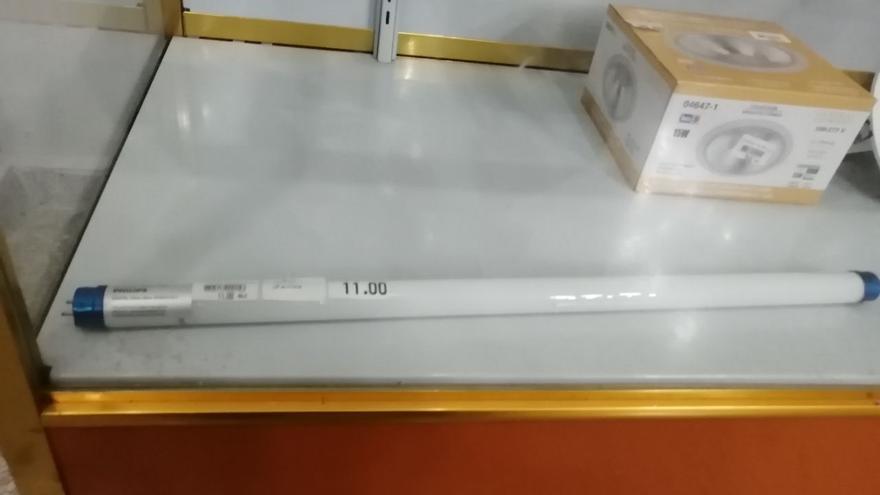
![]() 14ymedio, Juan Diego Rodríguez, Havana, 8 February 2021 — The light bulb began flickering and two days later it was dead. Nena, a retiree in Central Havana who was using her old Singer sewing machine at the time, knew the darkened room was not a good sign. For more than a year, stores in Havana have not been selling lamps or bulbs for Cuban pesos.
14ymedio, Juan Diego Rodríguez, Havana, 8 February 2021 — The light bulb began flickering and two days later it was dead. Nena, a retiree in Central Havana who was using her old Singer sewing machine at the time, knew the darkened room was not a good sign. For more than a year, stores in Havana have not been selling lamps or bulbs for Cuban pesos.
“My first idea was to take the bulb from the patio and use it in the room but when I tried it, the lamp still didn’t work,” she says. “My sons thought maybe it was the starter but it turned out to be more serious than that. The lamp’s transformer had broken.”
For Nena replacing the lamp has been “a mission impossible.” Due to the national economic crisis, many basic consumer items — from rugs to cement to candles — have disappeared from the shelves of state-owned stores. The situation has gotten worse during the months-long pandemic, when only grocery stores have been allowed to remain open.
“They closed everything: stores that sell shoes, plumbing supplies, even electric mixers. As if the coronavirus was going to prevent those things from breaking and people didn’t need to replace them,” complains Nena.” When some of those products became available again, they could only be found in hard currency stores. To have white light, you need greenbacks,” she notes ironically.
There was so much pent-up demand that when light bulbs became available again, they disappeared within a few days. Nena regrets that resellers used the opportunity to buy up everything they could and then jack up their prices. “I remember that a few years ago you could clap your hands and bulbs would come out of nowhere, incandescent as well as fluorescent,” she recalls.
Ever since Fidel Castro launched the “Energy Revolution,” old refrigerators and energy saving light bulbs have been in the spotlight.
Brigades of social workers, who basically served as Castro’s Red Guards, went from house to house, identifying high energy appliances, which were replaced with more energy efficient ones. Imports and sales of incandescent bulbs, both in pesos and in hard currency, were banned. The lucky few who managed to hold onto one hid it from prying eyes.
Energy-saving bulbs, also known as compact fluorescents (CFLs), replaced incandescents but were unpopular due to their short lifespans and low light levels. The new bulbs’ coiled shape became a symbol of the Energy Revolution, as the program was named in 2006.
Juan Alberto, who at the time was a teenager with dreams of singing on a stage filled with brightly colored lights, must now grope his way around his room because he has been unable to find a replacement for a broken lamp for two months. “I’ve lost count of how many times I’ve stubbed my toes and how far I’ve walked looking for someone who will sell me one,” he says.
Juan Alberto learned that one could buy light bulbs, electrical cables, lamps and all manner of electrical supplies needed for both indoor and outdoor illumination at stores that only take payment in hard currency. The problem is that he does not have the required debit card linked to a bank account with foreign currency or a relative overseas who would send him dollars to make the required bank deposit.
“I have not seen a single light bulb in any store since the end of last year. It finally dawned on me that this could be an unsolvable problem.” After visiting more than a dozen state-owned stores, Juan Alberto only managed to find some obsolete DVDs, antiquated musical equipment and an electric hair straightener covered with dust.
Until he went to the renowned La Cubana hardware store, popularly know by its traditional name, Feíto and Cabezón, where Juan Alberto’s spirits sank. The fluorescent bulb he needed was right there in the store’s display window for the exorbitant price of eleven dollars. Frustrated, he walked several more blocks down Reina Avenue until he came across a man who whispered, “LED and fluorescent bulbs.”
For 150 pesos, a little more than six dollars, this underground merchant was selling one of the most desirable items to be found on the streets of Cuba. “I bought two, just in case, but when I got home, I found out the problem was the lamp, which isn’t for sale anywhere,” claims the Havana resident, who now recalls what he was told about hard currency stores during their rollout.
“I heard on television that they were supposed to be stores that only carried high-end merchandise. But a light bulb is not a luxury item. Nor is a chicken breast, nor a piece of cheese. We’ve learned to live without these things. But without light?” he asks. “Pretty soon we’ll have to go back to living in caves.”
____________
COLLABORATE WITH OUR WORK: The 14ymedio team is committed to practicing serious journalism that reflects Cuba’s reality in all its depth. Thank you for joining us on this long journey. We invite you to continue supporting us by becoming a member of 14ymedio now. Together we can continue transforming journalism in Cuba.
